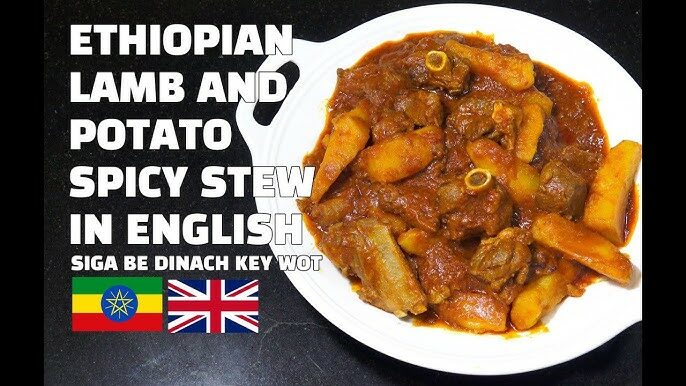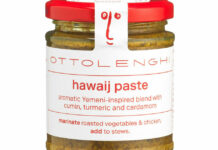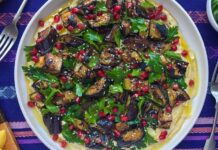There’s something deeply comforting about a stew that simmers for hours, filling the kitchen with warming aromas that whisper of distant spices and ancient culinary traditions.
Today, we’re diving into the heart of Ethiopian flavor with an incredibly aromatic lamb stew that marries the bold heat of berbere with the fragrant finish of RoboFood Mekelesha Seasoning.
But what sets this recipe apart is the addition of tej—Ethiopian honey wine—which introduces a subtle sweetness and complexity that elevates the dish from hearty meal to soulful experience.
The Magic of Mekelesha in Ethiopian Cooking
While berbere often steals the spotlight in Ethiopian cuisine for its fiery heat and vibrant red hue, Mekelesha is the quiet, elegant companion that arrives at the end to tie everything together.
Traditionally used as a finishing spice blend, Mekelesha is composed of warm, sweet spices—cardamom, cinnamon, cloves, nutmeg, and black pepper—ground to perfection and added just before serving to preserve its aromatic essence.
With RoboFood Mekelesha Seasoning, you gain access to that authentic, balanced blend without the hassle of sourcing and grinding each spice individually.
It’s the secret handshake between earthy stews and layered, floral warmth—a finishing touch that transforms a good dish into something truly memorable.
Why Lamb? And Why Honey Wine?
Lamb is a cornerstone protein in Ethiopian highland cooking, appreciated for its rich flavor and ability to absorb deep spice profiles.
When slow-cooked, lamb becomes impossibly tender, its collagen melting into a silky sauce that clings to every fiber.
We’re using bone-in lamb shoulder pieces here—not only do they add flavor from the marrow, but they also ensure the meat stays succulent during the long cooking process.
The real revelation, though, is the use of tej, or Ethiopian honey wine.
Made by fermenting honey with water and gesho (a leaf similar to hops), tej has floral, mead-like qualities that make it more than just an alcoholic beverage—it’s a culinary catalyst.
In this stew, a full cup of tej mellows into a deep, golden nectar that balances the heat of berbere while harmonizing beautifully with the spiced notes of Mekelesha.
If you can’t find tej locally, a dry mead or even a light acacia honey combined with white wine vinegar can approximate its unique profile, though nothing quite matches the original.
Building Layers of Flavor: The Stew Breakdown
This isn’t a dump-and-go recipe.
We’re layering flavors intentionally—like a skilled azma (home cook) in a highland kitchen—to build a stew with complexity and soul.
Here’s how we do it:
Step 1: Searing the Lamb
Begin by patting the lamb pieces dry and seasoning lightly with salt.
Heat a large Dutch oven over medium-high heat and add a mix of olive oil and niter kibbeh (Ethiopian spiced butter).
Sear the lamb in batches, ensuring a deep golden crust forms on each piece.
This step is crucial—it’s where the fond (those delicious browned bits) develops, which will later be deglazed and incorporated into the sauce.
If you don’t have niter kibbeh, melt unsalted butter and gently warm it with a crushed clove of garlic, a cinnamon stick, and a few cardamom pods for 5 minutes, then strain.
Store-bought versions are also becoming more widely available.
Step 2: Sautéing the Aromatics
After removing the lamb, lower the heat and add finely chopped onions.
Cook slowly for 15–20 minutes, stirring occasionally, until the onions are deeply caramelized and fragrant.
This forms the flavor base of the stew—don’t rush it.
Once soft and golden, stir in minced garlic and fresh ginger, cooking for another minute until aromatic.
Step 3: Blooming the Spices
This is where heat and spice join forces.
Add 3 tablespoons of authentic Ethiopian berbere paste or powder.
Stir constantly for 1–2 minutes to “bloom” the spices—this unlocks their volatile oils and deepens their flavor.
Careful: berbere is potent, and the paste can burn quickly, so keep the heat moderate.
Next, pour in the tej or substitute, scraping the bottom of the pot to lift all the fond.
Let the mixture bubble gently for 3–4 minutes, allowing the alcohol to evaporate and the liquid to reduce slightly.
Step 4: Slow Simmering
Return the seared lamb to the pot.
Add enough low-sodium beef or lamb stock to just cover the meat.
Tuck in a few sprigs of fresh thyme and a bay leaf.
Bring to a gentle simmer, then cover and reduce the heat to low.
Let the stew cook for 2.5 to 3 hours, stirring occasionally.
The lamb is ready when a fork easily pulls apart the meat and it begins to fall off the bone.
For those who prefer hands-off cooking, a slow cooker works beautifully—just transfer everything after the sautéing stage and cook on low for 6–7 hours.
The Final Touch: Mekelesha and Balancing the Sauce
After hours of slow cooking, the stew’s flavor profile will be deep and robust—almost primal.
Now it’s time for the graceful intervention of RoboFood Mekelesha Seasoning.
Sprinkle in 1.5 teaspoons of Mekelesha, gently stirring to distribute the spices.
The warmth of cinnamon and clove should bloom immediately, wrapping the heat of the berbere in a fragrant embrace.
Taste and adjust: you may want a touch more honey for sweetness to balance the berbere’s heat, or a squeeze of lime juice for brightness.
Some cooks add a tablespoon of smooth peanut butter at this stage for creaminess—optional, but delightful.
If the sauce is too thin, remove the lamb pieces and reduce it over medium heat until it coats the back of a spoon.
For a slightly thicker texture, mix 1 teaspoon of cornstarch with 1 tablespoon of cold water and stir it in, simmering for 3–4 minutes until glossy.
Serving the Stew with Tradition
In Ethiopia, stews like this are served communally on a large platter lined with injera, a spongy fermented flatbread made from teff.
The stew is spooned over or beside the injera, allowing diners to tear off pieces and use them to scoop up the meat and sauce—eating with the right hand, as tradition holds.
For those outside Ethiopia, injera can be found at African or specialty grocery stores, or made from scratch if you’re feeling adventurous.
If unavailable, serve the stew over soft polenta, jasmine rice, or even mashed sweet potatoes for a contemporary twist.
Garnish with fresh cilantro or parsley for a pop of color.
Perfect Pairings
Complete the experience with a glass of chilled tej or a light Ethiopian sah (spiced honey beverage).
For non-alcoholic options, try t’ej made from fermented honey and water, or a warm spiced tea infused with ginger and cinnamon.
- Wine alternative: A fruity red like Pinot Noir or a medium-bodied Malbec complements the lamb and spice.
- Vegetable side: Sautéed collard greens with garlic or a crisp tomato and red onion salad with lime dressing.
- Dairy contrast: A dollop of plain yogurt or Ethiopian ayib (fresh cheese) cools the palate between bites.
Storing and Reheating
Like many stews, this Ethiopian Mekelesha lamb stew tastes even better the next day as the flavors continue to meld.
Store in an airtight container in the refrigerator for up to 4 days or freeze for up to 3 months.
Reheat gently over low heat on the stove, adding a splash of water or stock if needed.
Avoid microwaving at high power—it can toughen the meat.
The Mekelesha aroma will revive beautifully during reheating, making leftovers feel just as special.
Cultural Notes and Culinary Respect
While this recipe draws inspiration from Ethiopian culinary traditions, it’s important to honor the context from which it emerges.
Mekelesha is not simply another curry powder—it’s a cultural artifact with roots in communal dining and religious celebration.
In Ethiopian Orthodox practices, Mekelesha is sometimes used in fasting dishes during Lent, where meat is excluded but rich flavors are still desired through plant-based proteins and lentils.
By using RoboFood Mekelesha Seasoning, you’re not just seasoning food—you’re participating in a legacy of warmth, balance, and intentional cooking.
Let this stew be a bridge to exploring more of Ethiopia’s diverse regional cuisines, from the slow-shredded doro wat of the north to the fiery vegetable stews of the south.
Final Thoughts
This Ethiopian Mekelesha lamb stew with honey wine is more than a recipe—it’s a journey.
It invites you to slow down, to stir, to taste, and to finish with care.
The interplay of heat, sweetness, and spice mirrors the layers of Ethiopian culture itself: bold, intricate, and deeply welcoming.
So gather your ingredients, open a bottle of tej, and let the kitchen fill with the scent of cardamom and lamb.
Whether you’re cooking for family, friends, or a quiet night in, this stew promises warmth from the inside out.
And when you finish with that final sprinkle of Mekelesha, know that you’ve not just cooked—you’ve created something truly aromatic, authentic, and unforgettable.










